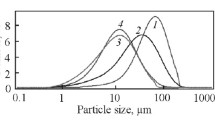Abstract
The structure of compacted specimens produced using the rapid laser melting of ultradispersed Fe–50 wt % Cu powders has been studied. The original powder was produced via the mechanical milling of iron and copper powders in a planetary-type ball mill. It has been found that the structure of the compacted specimens produced using rapid laser melting exhibits signs of the initial stages of separation in supercooled liquid. It has been shown using X-ray diffraction analysis as well as scanning and transmission electron microscopy that the final structure contains a supersaturated (Fe; Cu) solid solution formed from the high-speed movement of the solidification front and the nonequilibrium capture of copper by the moving front.
Similar content being viewed by others
References
Phase Diagrams of Binary Metallic Systems: A Handbook, in 3 vols., Ed. by N. P. Lyakishev (Mashinostroenie, Moscow, 1997) [in Russian].
O. Kubashevski, Iron—Binary Phase Diagrams (Springer, Berlin, 1982; Metallurgiya, Moscow, 1985).
E. A. Goodremon, Handbuch der Sonderstahlkunde (Springer-Verlag, Berlin, 1956, 3te Auf.; Metallurgiya, Moscow, 1966).
D. A. Mirzayev, I. L. Yakovleva, N. A. Tereshchenko, and V. N. Urtsev, “Thermodynamic analysis of the decomposition of a supersaturated solid solution of the Fe–Cu System,” Bull. Russ. Acad. Sci.: Phys. 76, 23–26 (2012).
S. S. Kiparisov and G. A. Libenson, Powder Metallurgy (Metallurgiya, Moscow, 1980) [in Russian].
P. Shen, J. Hu, Z. Guo, and Q. Guan, “A study on laser sintering of Fe–Cu powder compacts,” Metall. Mater. Trans. A 30, 2229–2235 (1999).
J. H. Liu, Y. S. Shi, K. H. Chen, and S. H. Huang, “Research on manufacturing Cu matrix Fe–Cu–Ni–C alloy composite parts by indirect selective laser sintering,” Int. J. Adv. Manuf. Technol. 33, 693–697 (2007).
M. Baricco, E. Bosco, G. Acconciaioco, P. Rizzi, and M. Coisson, “Rapid solidification of Cu–Fe–Ni alloys,” Mater. Sci. Eng., A 375–377, 1019–1023 (2004).
E. V. Kharanzhevskii, A. G. Ipatov, I. N. Klimova, and S. M. Strelkov, “Laser sintering of ultradispersed ironbase powder materials,” Phys. Met. Metallogr. 108, 504–509 (2009).
E. V. Kharanzhevskiy and M. D. Krivilev, “Laser sintering of Fe–Ni nanocomposites,” Phys. Met. Metallogr. 111, 53–61 (2011).
D. Herlach, P. Galenko, and D. Holland-Moritz, Metastable Solids from Undercooled Melts (Elsevier, Amsterdam, 2007; RKhD, Moscow, 2010).
E. V. Kharanzhevskiy and A. G. Ipatov, “Structure and topography of near-surface layers, obtained by laser high-speed sintering of Fe–C–Ni and Fe–C–Cu powders,” Vestn. Udmurt. Univ., Ser. Fiz., No. 1, 76–85 (2010).
Final Report on the RFFI Project no. 09-02-2110 ofi-m “Development of Technology of Laser High-Intense Sintering of Iron Nanopowders in a Nickel Shell for the Production of Nanostructured Surface Layers of Iron–Nickel Systems” (Udmurt. Gos. Univ., Izhevsk, 2010).
S. M. Reshetnikov, E. V. Kharanzhevskiy, and M. D. Krivilev, “Corrosion-electrochemical behavior of composite layers obtained by laser sintering of nanosized iron–nickel powders,” Korroziya: Materialy, Zashchita, No. 5, 18–24 (2011).
E. V. Kharanzhevskiy and S. M. Reshetnikov, “Effect of nickel distribution on the electrochemical properties of synthesized layers from Fe–Ni nanocomposite,” Yader. Fiz. Inzhin. 2, 235–239 (2011).
E. P. Elsukov, A. L. Ul’yanov, A. V. Protasov, and D. A. Kolodkin, “Solid-state reactions upon mechanical alloying of an Fe32Al68 binary mixture,” Phys. Met. Metallogr. 113, 602–611 (2012).
M. D. Krivilev, E. V. Kharanzhevskiy, V. G. Lebedev, D. A. Danilov, E. V. Danilova, and P. K. Galenko, “Synthesis of composite coatings using rapid laser sintering of metallic powder mixtures,” Phys. Met. Metallogr. 114, 799–820 (2013).
I. Yamauchi, N. Ueno, M. Shimaoka, and I. Ohnaka, “Undercooling in Co–Cu alloys and its effect on solidification structure,” J. Mater. Sci. 33, 371–378 (1998).
Y. Nakagawa, “Liquid immiscibility in copper–iron and copper–cobalt systems in the supercooled state,” Acta Metall. 6, 704–711 (1958).
D. G. Aarts, J. H. Wiel, and H. N. Lekkerkerker, “Interfacial dynamics and the static profile near a single wall in a model colloid–polymer mixture,” J. Phys.: Cond. Matt. 15, S245–S250 (2003).
D. Beysens, “Critical phenomena,” in Material Sciences in Space. A Contribution to the Scientific Basis of Space Processing (Springer-Verlag, Berlin, 1986), pp. 191–224.
S. Bastea and J. L. Lebovitz, “Domain growth in computer simulations of segregating two-dimensional binary fluids,” Phys. Rev. E: Stat., Nonlin. Soft Matter Phys. 52, 3821–3826 (1995).
J. W. Cahn and J. E. Hillard, “Free energy of a nonuniform system. I. Interfacial free energy,” J. Chem. Phys. 28, 258–267 (1958).
D. Jou, J. Casas-Vazquez, and M. Criado-Sancho, Thermodynamics of Fluids under Flow (Springer-Verlag, Berlin, 2001).
G. I. Sil’man, “About retrograde solidus and stratification of melt in the Fe–Cu and Fe–Cu–C systems,” Metal Sci. Heat Treat. 51, 19–24 (2009).
L. Zwell, D. E. Carnahan, and G. R. Speich, “Lattice parameter of ferritic and martensitic Fe–Ni alloys,” Metall. Trans. A 1, 1007–1009 (1970).
Author information
Authors and Affiliations
Corresponding author
Additional information
Original Russian Text © E.V. Kharanzhevskiy, 2016, published in Fizika Metallov i Metallovedenie, 2016, Vol. 117, No. 9, pp. 920–926.
Rights and permissions
About this article
Cite this article
Kharanzhevskiy, E.V. Separation in liquid and the formation of supersaturated solid solutions in Fe–Cu alloys upon rapid laser melting. Phys. Metals Metallogr. 117, 889–895 (2016). https://doi.org/10.1134/S0031918X16070097
Received:
Accepted:
Published:
Issue Date:
DOI: https://doi.org/10.1134/S0031918X16070097




